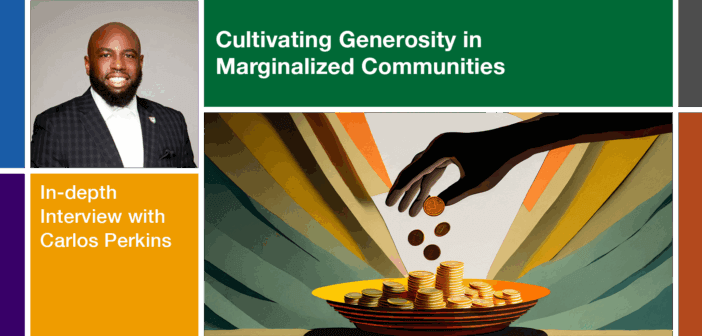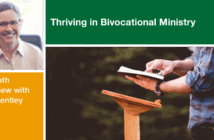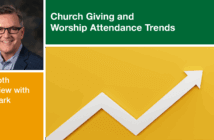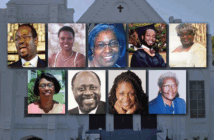How can church leaders cultivate generosity in marginalized communities? In this interview, Jessica Anschutz speaks with Carlos Perkins who emphasizes that many Black, Latinx, and Hispanic congregations have been historically generous, despite limited resources. The conversation explores the importance of defining generosity, reflecting on personal beliefs about money, and how faith leaders can develop a theology of generosity. Perkins also highlights how past institutional traumas can affect a congregation’s generosity, and the need for leaders to address these issues to foster giving.
Watch the interview video, listen to the interview, or continue reading.
Jessica Anschutz: Carlos, thank you for taking the time to speak with me today about cultivating generosity in marginalized communities. In your writing you have raised the question, “How do we cultivate generosity with communities that have historically had a tenuous relationship with money?” How can church leaders approach this important yet challenging work?
Carlos Perkins: Over the last two years, through the Lake Institute, we have had the opportunity to work with faith leaders, pastors, bishops—leaders within their own context—that are leading in the Black, Latinx, Hispanic church. Oftentimes when we approach the conversation about cultivating generosity within their context, we immediately receive feedback that a lot of these contexts and communities have historically been generous. I think about the work of Tyrone Freeman, a professor at IU Indianapolis, that talks about Madam C. J. Walker, who in her history of generosity did not wait until she became a millionaire to be generous but had a history of generosity.
Many of the faith leaders that I’ve worked with, walked alongside, and coached over the last two years, will say “Carlos, our congregation has historically been generous. We have been able to build on very little access to resources and historically our congregation has given.” It might not have been given resources because of our tenuous relationship with resources. And so, our conversations shift from the historic perspective around philanthropy, the historic perspective around giving and generosity, to how do you work within your context to continue to cultivate generosity, as it relates to resources? It’s not only generosity and financial resources, but how do you cultivate giving of time, talent, treasures, testimonies, and connection? And when we shift the conversation beyond resources, then a lot of these faith leaders respond to say, “Oh, there’s something that we can learn and something that we can engage in.”
Jessica Anschutz: Broadening resources helps folks engage in the conversation. What are some of the other challenges that church leaders need to keep in mind when doing this work?
Carlos Perkins: First, whenever we start course, we begin with a definition of generosity. This tends to invoke a lot of conversation from faith leaders, especially in the Black and Brown communities. As a foundation for our conversation, we use a definition from Christine Smith and Hilary Davidson that helps us to define generosity. Smith and Davidson define generosity as “The virtue of giving good things to others, freely and abundantly.” Within the definition, they talk about how, like all virtues, generosity is in people’s self-interest to learn and practice. When we start our conversations with that kind of definition, it pushes the audience to think about how much work they do in cultivating generosity. We ask the question, “think about the other biblical virtues. How much time do you spend teaching and preaching about faith? Love? Long suffering? Joy?” And oftentimes they’ll say, “Well, we do that often. We do that weekly, or monthly, or at least three times for the year.” But then we ask, “How much time do you spend teaching and preaching about generosity? How do you cultivate a theology within yourself, first, and then within your audience, congregation, and community to embrace generosity as a virtue?”
Jessica Anschutz: How do you find that these church leaders are doing that work to cultivate generosity within themselves first?
Carlos Perkins: First, it’s wrestling with your own history of generosity. We often ask the question, “What is your earliest memory of giving or receiving?” We layer that conversation with “What is your theology of giving? What is your theology of money?” And often when we are talking with pastors, with faith leaders within diverse communities, the conversation begins with “What did you learn from your family of origin about money?” And that invokes responses from, “We never talked about money,” to “We didn’t talk about it because we didn’t have it,” or “This wasn’t a consistent conversation within our community,” or “I didn’t talk to my mom and dad about it, but my grandparents would say to me, ‘Work hard, save, because we want to make sure that you can prepare for those that are yet to come in ahead of you.’”
And so, we often start our conversations with faith leaders by asking: “How do you interrogate your own foundational beliefs around money? Where did you start to build? Who taught you about your interaction with money? And how do you translate this to the audience in which you are serving? What are the biblical texts that you use when you’re talking about generosity? Is it from the perspective of these two frameworks that we share?” We tell our pastors that there are two frameworks when it comes to cultivating generous givers. There are those who operate from a traditional paradigm and those who operate from an emerging paradigm. A traditional paradigm adopts the idea that folks see there is a theology of duty. If I’m part of an organization or institution, then I have a responsibility and a duty to contribute to the organization. The emerging paradigm comes from a theology of response. You are so clear about the vision and mission of the organization that you invite others to respond to your mission and vision, social justice work, and/or your social impact.
For faith leaders to really interrogate and continue to cultivate donors within their context or congregation, they too must first interrogate themselves. Do you get your theology of duty right? Do you espouse scripture or texts that support that paradigm versus an emerging paradigm? Or are you writing the vision and making it plain to the people? Are you using an Old Testament Malachi text that says, “will a man or woman rob God?” And so, when we engage and invite pastors and leaders into that conversation, they become more self-aware of their own generosity and their own foundation and how it impacts how they teach and preach.
Jessica Anschutz: So, the first step is Interrogating yourself and thinking about how you teach it. What’s the next step, as far as working with the congregation or within the ministry context in order to cultivate generosity?
Carlos Perkins: The next step is to ask, “What do we know from the national trend in terms of giving?” We invite our audience to walk with us through the Giving USA report that is published yearly, or other statistics that we share, other research that we have through the Lilly Family School of Philanthropy, to say “This is what giving to religion looks like in 2023” (with a report that was published in 2024). Religion is still the largest recipient of philanthropic dollars, but if you look back over the last 40 years, giving to religion has been in decline. You have less givers that are giving more. Individuals are giving to organizations because there are more nonprofit organizations available that are asking folks to give and are appealing to the philanthropic world.
Are you clear about what you’re asking individuals to give to? With our faith leaders, we often we pause in the middle of our training sessions and say, “What is the appeal?” We share with them, “You have the awesome responsibility, as a congregational leader to interface with your donors on a weekly basis. What are you sharing with them during that time about generosity? Is it an invitation? Do you have some intentionality of engaging? Are you clear about what you are called as an organization or congregation, to do? How are you inviting others to partner with you and partner with God to bring that mission and vision to fruition?”
And so, it starts with the pastor, with a faith leader interrogating the self. It then builds to the place where we’re looking at national statistics, and trends in giving, and then we transition to the point of “What are you doing as a local congregation to receive, manage, spend and regard finances? How are you inviting others?” And then, we say to pastors, “Let’s interrogate our own institutions, our own congregations, about the challenges for that organization to become generous.”
I love this part of our conversation because we talk about institutional life traumas. If you look at your institution, what are the things that might have happened? Those traumatic things that we might or might not talk about that hinder your organization from becoming generous? And often, pastors and faith leaders, will say to us, “Carlos, it’s not my local congregation, but it’s my connection to the denomination. I don’t have control over what’s happening with the denomination. I know what’s happening with my local congregation, but I don’t know how to control the public image, if I’m connected to a denomination.” And so, understanding the impact that institutional life traumas can have on your local institution, and its ability to become generous, what are the conversations that are happening nationally or locally about your congregation? About churches in general? And how that might impact you? What are the things that have happened?
I remember a story where we were teaching a cohort of pastors, and one of the pastors shared that they wanted to engage in a small capital campaign to purchase a vehicle for the church. It was a clear vision; there was a clear need that there were more and more individuals who needed transportation to get to the worship service and other activities. They wanted to expand the youth and young adult ministry, and it needed transportation. They introduced a vision with some clear goals, a timeframe, and thought the congregation was going to be excited about it, only to face some resistance. After further interrogating the source of the resistance, the pastor shared that one of the congregants said, “Well, the last time we did a project, we gave towards purchasing a bus, and we have yet to see a bus.” This was before this pastor’s appointment, and they weren’t necessarily aware of that prior to this new vision. And so, the conversation then is how do you go back, deal with, and resolve some of those traumatic experiences to help the organization? So, it’s not that they’re not clear about the vision. They’re clear about what God is doing, how God is leading the institution in this time; but they still have this unresolved traumatic experience that’s preventing the organization from becoming a generous organization.
Jessica Anschutz: That’s a really important piece to this work. Are there pitfalls that church leaders should avoid in doing the work?
Carlos Perkins: Absolutely. Generosity, like other virtues, takes time to develop and mature. We must be intentional about preaching and teaching about generosity. When you engage in one of our courses, workshops, or seminars, we’re not going to give you the 10 steps for a generous congregation, and then you’re going to go back and next week that that’s going to happen. We often share this cycle of giving, that continuous evaluation, plan, evaluate, implement. Don’t think, “Now that I’ve gone out, now that I’ve engaged, now that I’ve read this book, I’ve read this pamphlet, I’m going to take this back to my congregation, and suddenly they’re going to be ready for a capital campaign, or they’re going to be ready to maximize their generosity.” Cultivation takes time. It is more like farming than it is like hunting. It requires us to plant a seed, to cultivate the soil, to water the soil, to talk to the plant, to encourage the plant, to go back and check on the plant before you can go in and reap the crop.
It also requires that generosity in religious fundraising is infused into our overall pastoral leadership. I often share that, in my pastoral role over the last 23 years, I’ve had congregants come to me and say, “Hey pastor, I found the person of my dreams and would love to engage in premarital counseling.” And during the premarital counseling it is a discerning process. I know what you feel, but let’s discern to make sure that this is a person that God has sent for you to walk with for eternity. Cultivating generosity is a discerning process as well for the congregation and for the individual. It is the faith leader’s role to help their congregation and individuals cultivate the ways in which they want to be generous. It is a discerning process, and it is a process that takes commitment and intentionality from the leader. And so, when we train leaders, when we engage in conversation with faith leaders, we’re also saying, “This cultivating process takes time. Do not get weary. It might not happen overnight.”
Now, there are some quick wins. I can share with you that we have engaged in cohorts, and immediately the week following a cohort experience, we’ll get a phone call from a pastor who says, “Dr. Perkins, this really works! I have been wrestling with the idea, and especially around a conversation on asking for a major gift,” and a major gift can be relative, it depends on your context. A major gift could be $500, and it could be $5,000,000. I’ve had pastors after a cohort call on the Sunday or the week after to say, “Hey, this person I’ve been talking to even before the class, but now that we’ve engaged in the course we’ve engage in the seminar, now I have the language and actually set up a conversation, had a conversation, made the ask, and they actually said, yes.”
One pastor reached out to me, Jessica, and said on a Sunday morning, right before worship, she had a meeting and asked for a major gift of $30,000. And the person said yes. And her response to me was, “Wow, I really pastor some generous people. It really just required me to get to the place where I wrestle with my own discomfort in having these kinds of conversations. The people were ready, but I wasn’t ready.” And so, how do we help faith leaders to equip themselves to be able to engage in a conversation, in a discerning process with their congregation, with individuals around being more generous?
Jessica Anschutz: What fruitful and exciting work you all are doing. You’ve referenced a couple of times, cohorts and resources, and I want to give our listeners a chance to learn from you about how best to tap into the resources that you offer.
Carlos Perkins: Let me invite your audience to check out our website: https://lakeinstitute.org/. We are a part of the Lilly Family School of Philanthropy at Indiana University, Indianapolis, and there are a number of resources on our website. You can also check us out on Twitter, Instagram, and on all the social media handles. I want to highlight a couple of our resources. The first is “The Story Shelf.” This is a collection of stories from across the country of congregations that are engaging in community impact work, community transformational work, leadership work in areas where one might think that it might be more difficult. So, stories around small congregations that have been able to partner with other congregations, with other community agencies, to maximize either building use and space or an idea to help to fund or resource the work that God is calling them to do. Congregations that engage the process of discernment to identify their congregational call. As a part of the story shelf, we are banking some information on philanthropy in the Black Church. These are specifically Black congregations from around the country that are doing the work of social impact, that are engaging with organized philanthropy to be able to do the work of community transformation. I’m happy to report that we just published a report on cultivating generosity within the Latinx Hispanic community that is very informative.
Additionally, we offer an executive certificate in religious fundraising. This is our anchor educational program. We invite individuals to check us out online and you can register for one of our courses and be a part of a cohort online. We also offer the same executive certificate and religious fundraising with partner organizations across the country. And so, we might be in a city close by that you want to engage. We’ll be in Washington, D.C. later on in the summer. We’ll be in Nashville and Charlotte, we’ll be in Austin, Texas. You can go online again at lakeinstitute.org and see the different cohort classes that we are offering.
Lastly, we have a brand-new short course on the spiritual side of capital campaigns that we developed after hearing from our partners and our faith leaders who said, “Hey, you touched on this for 15 minutes doing the executive certificate in religious fundraising. We need more on this particular topic.” This may be of particular interest to those looking at a capital campaign that is $300,000 or less – those who might not have the resources to engage an expert or a consultant to come in, and so you’re doing some of the work by yourself as a faith leader with some of your leadership in your context. The course is three sessions, and it starts in January 2025.
Jessica Anschutz: Thank you for taking the time to highlight just some of the wonderful resources for church leaders who are doing this work and often feeling intimidated by that work. I want to ask you as we wrap up: What words of encouragement do you have for church leaders who are seeking to cultivate generosity in marginalized communities?
Carlos Perkins: If there’s one thing that we can encourage faith leaders to do, it is to be clear. Spend some time discerning with the Holy Spirit around your congregational call. We are seeing through the national trend, through our Giving USA report, through this emerging paradigm that more and more individuals are looking to partner with organizations that have a clear vision and mission around how they’re impacting the world beyond the walls of their congregation. The work around organized philanthropy and its relationship, both in terms of this intentionality in partnering with diverse communities, is directly aligned to what social impact work you’re doing as a congregation. Try not to be discouraged by what you might see in front of you; that is, God has given a vision. He’s also providing the provision, the resources to do it. The resources might not be sitting right in front of you in the congregation. And so, I encourage faith leaders to be clear about your mission and vision and invite others to join you. Discern in community, there are individuals right now that exist outside of your immediate congregation, that are looking for opportunities to partner with you and with God to make an impact in the broader community. That’s my advice.
Jessica Anschutz: Thank you so much, Carlos, for your time and your inspiration and also your ministry.
Carlos Perkins: Thank you.
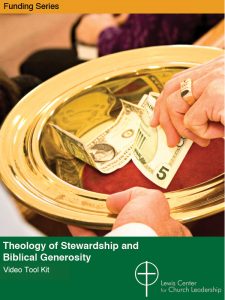 Related Resources
Related Resources
- 50 Ways to Encourage Faithful Giving, a free resource from the Lewis Center
- Cultivate Generosity Through Thankful Giving by Sharron Blezard
- 7 Practical Strategies for Nurturing a Culture of Generosity by Ann Michel and Lovett Weems
- Theology of Stewardship and Biblical Generosity, a Lewis Center video tool kit resource
If you would like to share this article in your newsletter or other publication, please review our reprint guidelines.

